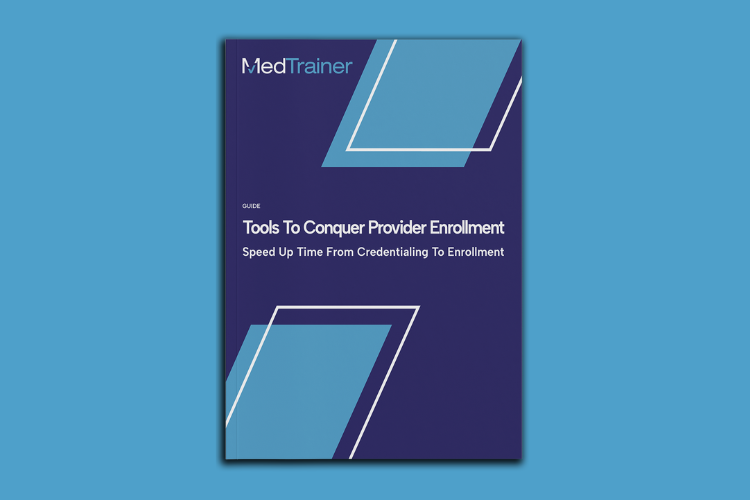Federally qualified health centers (FQHCs) are mandated to provide comprehensive healthcare services to medically underserved areas and populations, including those with limited access to healthcare due to factors such as income, location, or insurance status. FQHCs receive federal funding through grants and reimbursements from the Health Resources and Services Administration (HRSA), an agency of the U.S. Department of Health and Human Services (HHS). So, it makes sense that FQHC credentialing would be at the forefront of new practices and technology.
Let’s look at the industry’s unique credentialing process, challenges, and how FQHCs are adopting technology to prepare for the future.
The Credentialing Process for FQHC Providers
The credentialing process for FQHC providers is similar, if not the same, as in other care settings. The process spans various stages, including primary source verification, work history and reference checks, background checks, and payer enrollment, potentially extending up to 150 days. At a minimum, these are standard documentation requirements:
- National Provider Identification (NPI) number
- Current Curriculum Vitae (CV)
- Copies of professional state licenses and DEA licenses
- Board certification information
- Professional liability insurance information
- Peer and professional references
- Continuing Medical Education (CME) documents
Providers or organizations must also decide which insurance companies they will accept. This initial choice can significantly impact the FQHC patient base and operational dynamics. Following this, providers embark on the enrollment phase, a prerequisite for accepting insurance and treating patients.
Many payers require providers to maintain a CAQH ProView profile. CAQH credentialing is designed to alleviate the work for providers because many major payers can access that information without the provider completing a separate application.

Get the tools you need to eliminate delays in your provider enrollment process.
Common Challenges in FQHC Credentialing
FQHCs offer primary care services, including medical, dental, behavioral health, and preventive care. They also often provide additional services such as pharmacy and laboratory services and enabling services like transportation or translation. Any challenges encountered in the credentialing process can have a significant financial impact on the center when a physician cannot see patients or claims are being denied.
Here are some of the most common challenges in FQHC credentialing:
- Provider Shortages and Turnover: FQHCs may struggle to recruit and retain qualified healthcare providers, and turnover is common due to burnout, relocation, or retirement. Managing provider turnover and ensuring continuity of care for patients can be challenging, particularly in underserved areas where replacement providers may be difficult to recruit.
- Complex Regulatory Environment: FQHCs must adhere to a complex regulatory environment, including federal regulations outlined by the Health Resources and Services Administration (HRSA), state regulations, and accreditation standards. Navigating these regulations and ensuring compliance can be challenging and time-consuming.
- Patient Population Diversity: FQHCs often serve diverse patients with varying cultural backgrounds, languages, and health needs. Credentialing providers who can effectively communicate and provide culturally competent care to this diverse patient population can be challenging.
- Credentialing for Specialized Services: Credentials working in FQHCs must credential for many specialized services, such as behavioral health, dental care, or specialty medical services. Keeping up with the requirements and regulations of many specialities can be challenging.
- Limited Resources: Many FQHCs operate with limited financial resources, which can impact their ability to invest in credentialing processes and infrastructure. Limited resources may also affect the availability of staff dedicated to credentialing activities, leading to delays and inefficiencies in the credentialing process.
- Data Management: FQHCs must maintain accurate and up-to-date records for credentialing purposes, including provider credentials, licensure, certifications, and continuing education credits. Managing this data manually or with outdated systems can be cumbersome and prone to errors.
- Credentialing Delays: The credentialing process can be lengthy, involving gathering and verifying extensive documentation, conducting background checks, and obtaining references. Delays in the credentialing process can impact FQHCs’ ability to onboard new providers and expand services to meet patient demand.
Addressing these challenges head-on with strategic planning and technology can streamline the FQHC credentialing process, ultimately benefiting providers and patients.
Optimizing Credentialing Through Technology
Adding technology to your credentialing process offers speed and efficiency that cannot be replicated using a manual process. That’s why Infinity Business Insights predicts the global provider credentialing software market, valued at $1.3 billion in 2021, will reach $5.6 billion by 2030. Innovations that offer enhanced accessibility, scalability, and data security are in high demand as FQHCs look for ways to streamline the credentialing workflow.
Automation
Automating tedious and time-consuming tasks such as reminding providers to submit documents and checking exclusions databases helps free up time for credentialers and reduces frustration. Leading credentialing software offers a secure online portal for providers to upload the documents required by your FQHC and automated email reminders that continue until completed. You can also automate reminders to stay on top of important deadlines, like re-credentialing and expiration. Automated exclusions monitoring and license verification eliminate the website hopping and waiting — again, freeing up valuable time for credentialers to spend on the tasks that require a human touch.
Workflows
With so many moving parts in the credentialing process, it is easy to miss a step or let too much time pass between steps. Credentialing software offers customizable workflows to keep your FQHC process on track so you can submit a complete credentialing packet the first time. Workflows may include a checklist with assignable tasks, reminders, and dashboards showing outstanding items and due dates.
Transparency
Without credentialing software, it is tough for leadership to have visibility into the process — or for the process to continue uninterrupted if a credentialer leaves the organization. With all documents and information in a central provider profile and all actions tracked in one cloud-based platform, anyone with access can see precisely what has been completed and what is yet to be done for each provider. Dashboards can provide this in a high-level view with the enrollment metrics needed to make business decisions.
Real-Time Reporting
The in-depth reporting included with leading credentialing software provides the insight and visibility you need to keep processes on track and share data with leadership through scheduled reports emailed regularly (daily, weekly, monthly). Every FQHC operates differently and prioritizes different metrics. Make sure to choose software with customizable enhanced credentialing reporting so you can select the data and filters you need, then save the reports you use most often.
By leveraging these technological advancements, the FQHC can enhance efficiency, reduce errors, and maintain compliance, ultimately improving patient care and operational effectiveness.
The Future of Credentialing in FQHCs
As the industry moves toward a more efficient future, the role of technology, particularly credentialing software, becomes undeniably central in optimizing operational effectiveness and enhancing patient care quality. The advent of AI to enable efficiency in credentialing processes not only promises enhanced security and accessibility but also paves the way for a more seamless healthcare delivery system.
For those looking to advance their FQHC credentialing process with cutting-edge technology, explore how MedTrainer Credentialing Software can significantly reduce turnaround times and improve accuracy. This is a pivotal step toward operational excellence and unparalleled patient care.
